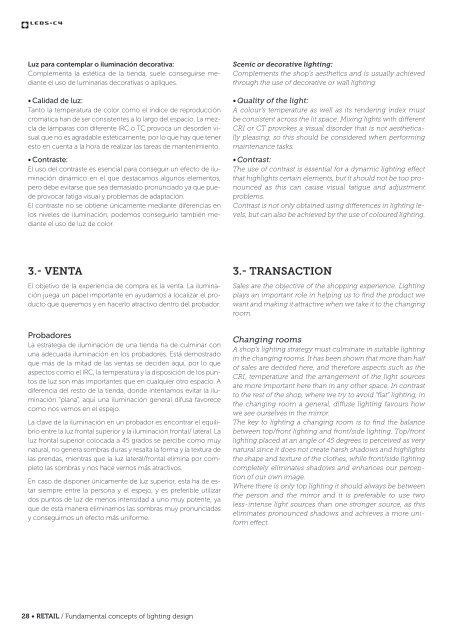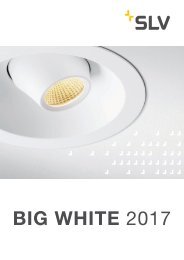RETAIL_2016
Create successful ePaper yourself
Turn your PDF publications into a flip-book with our unique Google optimized e-Paper software.
Luz para contemplar o iluminación decorativa:<br />
Complementa la estética de la tienda, suele conseguirse mediante<br />
el uso de luminarias decorativas o apliques.<br />
• Calidad de luz:<br />
Tanto la temperatura de color como el índice de reproducción<br />
cromática han de ser consistentes a lo largo del espacio. La mezcla<br />
de lámparas con diferente IRC o TC provoca un desorden visual<br />
que no es agradable estéticamente, por lo que hay que tener<br />
esto en cuenta a la hora de realizar las tareas de mantenimiento.<br />
• Contraste:<br />
El uso del contraste es esencial para conseguir un efecto de iluminación<br />
dinámico en el que destacamos algunos elementos,<br />
pero debe evitarse que sea demasiado pronunciado ya que puede<br />
provocar fatiga visual y problemas de adaptación.<br />
El contraste no se obtiene únicamente mediante diferencias en<br />
los niveles de iluminación, podemos conseguirlo también mediante<br />
el uso de luz de color.<br />
Scenic or decorative lighting:<br />
Complements the shop’s aesthetics and is usually achieved<br />
through the use of decorative or wall lighting<br />
• Quality of the light:<br />
A colour’s temperature as well as its rendering index must<br />
be consistent across the lit space. Mixing lights with different<br />
CRI or CT provokes a visual disorder that is not aesthetically<br />
pleasing, so this should be considered when performing<br />
maintenance tasks.<br />
• Contrast:<br />
The use of contrast is essential for a dynamic lighting effect<br />
that highlights certain elements, but it should not be too pronounced<br />
as this can cause visual fatigue and adjustment<br />
problems.<br />
Contrast is not only obtained using differences in lighting levels,<br />
but can also be achieved by the use of coloured lighting.<br />
3.- VENTA<br />
El objetivo de la experiencia de compra es la venta. La iluminación<br />
juega un papel importante en ayudarnos a localizar el producto<br />
que queremos y en hacerlo atractivo dentro del probador.<br />
3.- TRANSACTION<br />
Sales are the objective of the shopping experience. Lighting<br />
plays an important role in helping us to find the product we<br />
want and making it attractive when we take it to the changing<br />
room.<br />
Probadores<br />
La estrategia de iluminación de una tienda ha de culminar con<br />
una adecuada iluminación en los probadores. Está demostrado<br />
que más de la mitad de las ventas se deciden aquí, por lo que<br />
aspectos como el IRC, la temperatura y la disposición de los puntos<br />
de luz son más importantes que en cualquier otro espacio. A<br />
diferencia del resto de la tienda, donde intentamos evitar la iluminación<br />
“plana”, aquí una iluminación general difusa favorece<br />
como nos vemos en el espejo.<br />
La clave de la iluminación en un probador es encontrar el equilibrio<br />
entre la luz frontal superior y la iluminación frontal/ lateral. La<br />
luz frontal superior colocada a 45 grados se percibe como muy<br />
natural, no genera sombras duras y resalta la forma y la textura de<br />
las prendas, mientras que la luz lateral/frontal elimina por completo<br />
las sombras y nos hace vernos más atractivos.<br />
En caso de disponer únicamente de luz superior, esta ha de estar<br />
siempre entre la persona y el espejo, y es preferible utilizar<br />
dos puntos de luz de menos intensidad a uno muy potente, ya<br />
que de esta manera eliminamos las sombras muy pronunciadas<br />
y conseguimos un efecto más uniforme.<br />
Changing rooms<br />
A shop’s lighting strategy must culminate in suitable lighting<br />
in the changing rooms. It has been shown that more than half<br />
of sales are decided here, and therefore aspects such as the<br />
CRI, temperature and the arrangement of the light sources<br />
are more important here than in any other space. In contrast<br />
to the rest of the shop, where we try to avoid “flat” lighting, in<br />
the changing room a general, diffuse lighting favours how<br />
we see ourselves in the mirror.<br />
The key to lighting a changing room is to find the balance<br />
between top/front lighting and front/side lighting. Top/front<br />
lighting placed at an angle of 45 degrees is perceived as very<br />
natural since it does not create harsh shadows and highlights<br />
the shape and texture of the clothes, while front/side lighting<br />
completely eliminates shadows and enhances our perception<br />
of our own image.<br />
Where there is only top lighting it should always be between<br />
the person and the mirror and it is preferable to use two<br />
less-intense light sources than one stronger source, as this<br />
eliminates pronounced shadows and achieves a more uniform<br />
effect.<br />
28 • <strong>RETAIL</strong> / Fundamental concepts of lighting design









